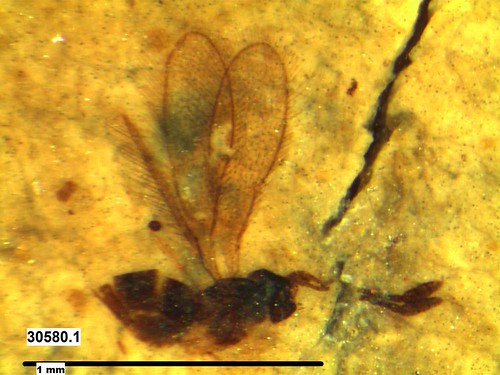
An intrepid fossil hunter on the U.S. Forest Service’s Flathead National Forest in northwest Montana doesn’t need to dig too deep to find exquisitely preserved fossil insects with traces of their original stomach contents. Amazing as this sounds you just need to visit rock outcrops of the Kishenehn Formation exposed on the banks of the Flathead River.
There, researchers affiliated with the Smithsonian’s National Museum of Natural History have discovered a treasure trove of tiny, 46-million year old fossil insects from the Eocene Epoch, which were deposited in sediments of an ancient lake early during the Age of Mammals. The preserved insects—over 7,000 specimens have been collected over the last several years—include fossil mosquitos. At least one specimen preserves an abdomen still engorged from its last meal.
Fossil DNA?
Not quite, but the preservation is exceptional enough to allow chemical identification of iron-containing heme subunits of the blood molecule hemoglobin.
Recognition of these 46-million year old biomolecules reflects advances in chemical analytical techniques that are now used in paleontology and would have been unheard of only decades ago. How did the tiny insects in these rocks come to be so well preserved?
To answer that, we need to visit the Eocene lake.

Imagine a cloud of insects arise at dusk, enshrouding the lakeshore in dense swarms after avoiding the harsh midday sun. A squall blows many far offshore. As the wind quells, disoriented fliers follow the moon’s shimmering reflection off the deeper lake’s glassy surface. Exhausted, they drop into the water. Far from the nutrient-rich shoreline, fish are few and many of the insect carcasses slowly settle undisturbed to the lake bottom.
Oxygen is nearly absent in the offshore lake-bottom muds, and there is little to disturb the settled remains, which are soon enmeshed in sticky mats of algal filaments that bind insects and sediment grains alike. Clay and silt particles continue to settle out from the water above to blanket the lake bottom, forming a seasonal rhythm of alternating shale layers called varves. Deeper burial beneath the varved lake bottom sediments eventually shut down decomposition of the buried insects.
Burial beneath hundreds to thousands of feet of sediments squeezes most of the organic material out from the carcasses into the pore spaces of the surrounding sediment—where it may contribute to oil formation. In fact, these rocks are often referred to as “oil shales.”
Left behind are thin insoluble carbon films and other chemicals residues which preserve in exquisite detail miniscule anatomical details and sometimes even gut contents, ultimately revealed by splitting the rock 46-million years later with a paleontologist’s rock pick.



